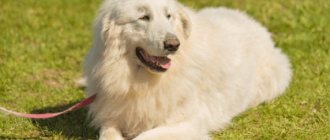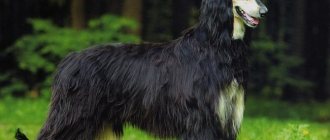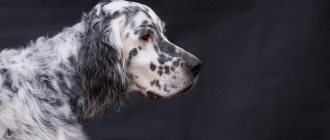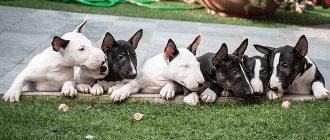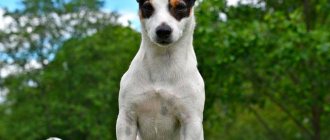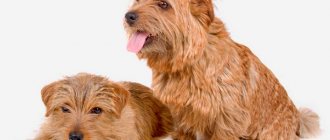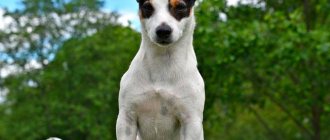Decorative small dogs are in great demand among modern people. However, you cannot make a choice in favor of a certain breed based only on the appearance of the future pet. It is necessary to thoroughly study the characteristics of the breed, weigh all the pros and cons, and only then purchase an animal. One of the most beautiful and interesting decorative breeds is the toy poodle. The representative of the family is distinguished by high intellectual abilities, good learning ability, excellent obedience, excellent socialization, and good character.
Main characteristics
| Breed parameters | |
| Country of origin: | Germany |
| Weight of the breed: | 3–5 kg |
| Height at withers: | 28 cm |
| Temperament: | calm |
| Wool: | middle length |
| Role in human life: | companion |
| Breed group: | decorative |
The Toy Poodle, like its relatives - the Royal, Medium and Dwarf - is recognized by its aristocratic haircut. The owner needs to spend a lot of time and attention on caring for the pet, especially its fur. The dog is hypoallergenic, almost does not shed, and is ideal for an owner with allergies.
Interesting Facts
There are quite a lot of interesting things associated with the breed:
- Images of dogs resembling poodles were found on coins of Ancient Rome and Greece, in ancient tombs.
- Representatives of the breed served in Napoleon's army. The soldiers put dogs in backpacks so that if they were wounded, they would draw attention to the soldiers with a ringing bark.
- Composer Richard Wagner always took his beloved poodle to orchestra rehearsals. Hearing false notes, the pet began to bark.
- The breed was loved by many famous personalities: Prince Charles, Ludwig van Beethoven, Winston Churchill, Elvis Presley.
- Toy poodles were recruited into the Japanese police force. They work in a search and rescue team, since large dogs often cannot crawl under the rubble.
Origin
The history of the breed begins in the twentieth century, when the first mini poodle puppy was bred in Germany. If dogs are now considered decorative, their original purpose was to hunt small game. But there are three more versions of the appearance:
- It was French dog breeders who appreciated the intellectual qualities of poodles and taught them to hunt, while others scoffed at their clumsy appearance. In the 17th century, dogs began to be called “poodles”.
- To develop this breed, a retriever, a shepherd dog and a standard poodle were crossed. They say that the word “poodle” is German and means “very wet.” This indicated the dog's hunting activity: it pulled shot game from water bodies.
- According to the third version, it originated from Central Asia - Mongolia or Tibet. The spread of animals around the world occurred thanks to sailors.
The ancestors of the modern mini poodle can be French, German, Russian and Hungarian shepherd dogs. This explains the rich colors of today's pets.
It was the toi that were bred by the Swiss dog handler Paul Schailin in 1840. The dogs were finally recognized in 1963 at a French exhibition, and a standard was developed at the same time.
Where is the best place to buy
When buying a puppy, it is advisable to give preference to nurseries or private breeders of the breed. In these cases, you can first discuss the planned mating, find out how much the dog costs now and what the cost of a poodle puppy from the future planned litter is. You will also have the opportunity to evaluate external characteristics and meet future parents.
There are a number of nuances that should make you wary and abandon the puppy. You should choose another nursery in the following cases:
- Lack of breeding documents. Under this guise, non-purebred and sick animals are often sold.
- Lack of documents on mating and its planning.
- Lack of veterinary passports, vaccinations and data on treatment against parasites; veterinarian stamps are required.
- Refusal to meet parents.
- Mom weighs less than 2.5 kg. Little daddy allowed.
- Clear signs of dwarfism. The size of the head is too large and its flat shape, hunchback and curvature of the limbs.
- Imposing the smallest puppy of the litter. Most often, these babies grow up to be large.
- Multiple or first litter. Such puppies usually cost much less.
Photo of a toy poodle
Toy does not know resentment, vindictiveness and aggression. He loves the family in which he lives; He is characterized by some shyness and sensitivity, especially to harsh voices or sounds. The breed prefers the company of people rather than dogs or other animals. She lacks watchdog qualities, although she is wary of strangers. But unlike its guard brother, it will not bark or growl at a stranger, but will run away from him.
The pros and cons of a toy dog attract the attention of many dog breeders. His virtues are balance, calmness, and a natural tendency to obedience. Representatives can even be quiet and shy, so they will not start barking for no reason. The breed is excellent for apartment living and can tolerate loneliness for a long time.
Character and behavior
Mini poodles are smart, noble, and loyal to their owner. They become strongly attached to people and do not tolerate loneliness well. Given these character traits, the breed should not be owned by a busy person. But if you give your dog enough attention, it will reveal all its positive qualities.
Toy poodles feel the mood of people, know how to be happy and sad with them. The breed is not at all aggressive, is easy to train, loves to play and have fun. But constant entertainment can become a source of additional noise - owners should be prepared for frequent loud barking.
The breed is indifferent to other dogs. But in relation to small pets, it can exhibit a hunting instinct. Well-mannered toy poodles get along well with children, but a small dog is very easy to injure - playing together should only take place under adult supervision.
Taking into account the nature of the breed, the Toy Poodle is suitable for an active person who can devote a lot of time to it. It is better not to leave the dog alone for a long time. But if such a need does arise, you should provide the dog with a variety of toys so that he can entertain himself.
Upbringing
If an animal begins to play pranks, it is enough to look at it sternly and order it to stop fooling around with the same intonation. Poodles have highly developed sensitivity, so one repetition will be enough.
Even though toys are small, they need moderate physical activity. Daily walks should last half an hour each. You can let your dog overcome obstacles within its strength and capabilities. They are perfectly adapted to swimming, so in the summer you can arrange such a pastime. You can play and run with them – children will really like it.
Training
Training a small pet is about honing socially significant skills. They will help the owner manage the dog in the future. The breeder must, by voicing commands, encourage the toy poodle to take certain actions:
- sit down;
- lie down;
- bring a specific item;
- return to place;
- guard a thing.
It is better to raise a puppy from 4 months of age. At this time, the dog tries to please the owner and happily completes the assigned tasks.
If the start of training is delayed until the age of one, then there is a risk of getting an uncontrollable animal with ineradicable bad habits. An adult dog must have positive qualities and obedience.
Care
The advantage of the dog is that it is hypoallergenic: it does not emit specific odors and practically does not shed. Of course, this becomes a compelling argument in favor of purchasing a puppy for allergy-prone, elderly or busy people who cannot devote much time to cleaning the room from fur.
But he is very clean, so he requires painstaking care: frequent bathing, trimming every month, timely trimming of nails, cleaning of eyes and ears.
The animal's fluffy fur requires attention: it must be trimmed on time to avoid tangles and sticky dirt, combed every day with a massage brush, and bathed once every 1.5-2 months. Claws, ears and teeth are vulnerable places, so the owner should carefully inspect them and remove dirt.
List of nicknames
When choosing a nickname for your pet, you should give preference to euphonious names. You can also choose the best option that reflects the character of your pet:
- Skoda
- Umka
- Sonya
- Weasel
- Snowstorm
- Storm
- Joy
The best names for a toy poodle are shown in the table:
| For boy | For girl |
| Charlie | Charlotte |
| Norton | Rose |
| Hummer | Sheila |
| Motya | Polly |
| Felix | Ciri |
| Leo | Nyusha |
| Theo | Flora |
| Casper | Mia |
| Sparky | Torah |
| Jerry | Lacey |
| Samson | Stesha |
| Goofy | Eve |
| Ram | Sima |
| Volt | Adele |
| Ricci | Ruta |
| Baron | Tuchka |
| Plato | Bun |
| August | Snowstorm |
| Oscar | Squirrel |
Video: toy poodle
Trimming is an essential aspect of not only caring for your pet. It is thanks to the haircut that the poodle is recognizable at first sight as a breed; it is prescribed by the standard. If a dog performs at exhibitions, trimming is a must. For example, there are the following types of haircuts:
- “Lion” means shaving the hair on the muzzle, hind legs from the beginning of the hock joint, one third of the tail, hips, groin and rump, and forearms. Thick fur remains only on the neck, forming a “collar”, like a lion’s.
- “Like a sheep” - the covering on the throat, belly, muzzle is shaved; on the paws and third of the tail.
- “Pappy Clip” – the soles, tail and muzzle get rid of fur. The rest of the fur is cut so that it is the same size along the entire length.
- “Anglo-Saxon” is an analogue of the “lion” haircut. The difference between this type of trimming is that in the area of the groin, lower back and croup the hair is not completely cut off, but 1–2 cm is left.
Health
A toy poodle, if all rules of maintenance and care are followed by the owner, can live up to 18-19 years. Moreover, the average life expectancy of these dogs is 14-16 years.
It cannot be said that a toy poodle has strong immunity and good health. These are animals that need care, they need to be well taken care of and the condition of the body must be closely monitored.
It is mandatory for a toy poodle to undergo examinations at a veterinary clinic 1-2 times a year. Deworming, vaccinations and treatment with anti-parasite medications are also required.
The owner of a toy poodle should familiarize himself with the diseases to which this breed is predisposed:
- Narcolepsy is a neurological disorder characterized by disturbances in nighttime sleep, persistent daytime sleepiness, and sudden “falling asleep” during the day.
- Cardiomyopathy – leads to the development of congestive heart failure.
- Urolithiasis is a pathology of the urinary system.
- Medial luxation of the patella is a genetic disease.
- Hair loss can occur as a result of severe stress.
- Diabetes mellitus is an endocrine disease that cannot be treated, but it can be controlled.
- Hydrocephalus is a congenital disease characterized by excessive formation and accumulation of cerebrospinal fluid in the cerebral ventricles.
- Caries is the destruction of hard dental tissue.
- Hypoglycemia is a decrease in blood sugar levels.
- Cryptorchidism is a hereditary anomaly in which the testicles are undescended into the scrotum.
- Tracheal collapse is a genetic, chronic degenerative disease associated with anatomical deformation of the tracheal rings.
- Inflammation of the tonsils - inflammation of the palatine tonsils, caused by coccal microorganisms, develops as a concomitant with plague and hepatitis.
- Damage to the anal glands - characterized by swelling and minor damage to the skin around the anus.
- Epilepsy - characterized by convulsions, seizures with involuntary urination.
- Hypothyroidism is insufficient or absent production of thyroid hormone.
- Immune hemolytic anemia is a disease of the immune system.
- Hemorrhagic gastroenteritis is an acute disorder characterized by vomiting and bloody diarrhea.
- Eye diseases – glaucoma, cataracts, retinal detachment, death.
- Chronic insufficiency in the atrioventricular valves - a chronic cough develops, sometimes with shortness of breath and cyanosis.
- Von Willebrand disease develops when there is a defective von Willebrand factor in the blood or a deficiency of it in the blood.
- Cushing's syndrome or hyperadrenocorticism is a disease of the endocrine system.
- Disorders between the discs of the spine lead to weakness of the limbs and limited movement.
Feeding
The toy's appetite is not rich: the dog eats little, so you should feed it healthy food and add special vitamins, especially phosphorus and calcium. For example, an animal’s breakfast may consist of fermented milk products, and dinner may consist of vegetables and meat (naturally, the frequency of feeding is suitable for an adult dog). For poodles, it is not recommended to mix dairy and meat products. Industrial and natural feeds are suitable.
| The diet should consist of the following products: | ||
| Meat | Chicken, beef | Needs to be boiled |
| Cereals | Buckwheat, oatmeal, rice | It is permissible to add vegetable oil |
| Fish | Marine, low-fat | Boiled |
| Vegetables | Any except legumes and potatoes | Can be either raw or boiled |
| Eggs | Quail | Allowed one 2 times a week |
| Fruits | All fruits | Rarely available as a treat |
Toys are known beggars, but their diet and appetite should be controlled so as not to harm their health. Toy should have strong muscles and fit. Up to 3 months, puppies are fed 5–6 times a day, from 3 to 4 times. An adult dog eats 2–3 times. If feeding is recommended on a schedule, then the animal must have constant access to water. Puppies are introduced to dry food from 1–3 months. If you need to transfer an animal from natural food to store-bought food, this is done over the course of half a month - the transition should be gradual.
Varieties
The breed is not officially divided into varieties. However, in Japan, small dogs were bred, 22–24 cm tall and weighing up to 3 kg, which were called the “Japanese toy poodle”. They are a genetic mutation and are considered defective.
The Japanese Toy Poodle cannot participate in exhibitions or breeding. Tiny dogs require even more careful care because they have weak skeletons and are prone to a whole bunch of diseases.
However, the Japanese Toy Poodle has the same friendly and positive personality. Following fashion trends, people keep him as a pet, despite possible problems.
There is also a detailed article about the Poodle dog breed.
Color and coat type
The Toy Poodle's body is covered with elastic and well-pigmented skin. In white dogs it is silver in color, in animals of all other colors it corresponds to the color.
Representatives of the breed can have two types of fur:
- Curly – elastic, with pronounced curls.
- Corded - the wool is divided into separate strands (so-called cords) at least 20 cm long.
The spine should be fine in structure, and the coat should be thick and fluffy. Sparse, flabby, hard fur is a serious drawback.
Allowed colors:
- Black is a classic color without any admixture of gray or brown.
- White – Dogs may be apricot or cream at birth, but after molting the color becomes uniform.
- Brown – rich, warm, uniform without beige or lighter tones.
- Gray is not close to black or whitish. Includes a range of gray, blue and silver shades.
- Red (red) - the dog can be light red, orange (apricot) or red in color. With age, the coat lightens and becomes less vibrant.
Important. Toy poodles with white markings in colored coats are disqualified.
In 2008, the RKF recognized two more colors - harlequin (black and white) and black and tan. Now such dogs are considered separate breeds: harlequin and phantom. They are not yet recognized by the FCI, but they are successfully bred in the USA, Germany, Austria, and the Czech Republic.
How to choose
The main difficulty in choosing a toy poodle puppy is the reliability with which the breeder offers to buy the animal. Taking advantage of the fashion for decorative dogs, unscrupulous sellers can pass off another lap dog as the same one. The owner must before purchasing:
- Make sure the information about the puppy’s pedigree, its parents, and breed parameters is correct.
- Meet with the breeder, ask about the documents for the dog, visit the kennel.
- Before purchasing, evaluate the physical and mental condition of the baby: how active and healthy he is in appearance.
Pros and cons of the breed
| pros | Minuses |
| People-oriented | Tendency to a number of diseases |
| Friendly character | Loud barking |
| Beautiful appearance | High injury rate |
| Learning ability | Difficult care |
| Compact dimensions | |
| Hypoallergenic wool | |
| Lack of aggression |
The Toy Poodle resembles a stuffed animal, but in reality it is an intelligent and loyal dog with a distinct personality.
The breed is equally well suited for both single and family people - the main thing is that the owner pays enough attention to the pet.
Lifespan
Toy poodles, despite their predisposition to many diseases, are surprising in their longevity.
If the owner follows the vaccination schedule and is attentive to the prevention of colds, the pet remains mobile and active.
Expert opinion
Anna Abramenko
An avid dog lover. Experience in veterinary medicine since 2009.
Ask a Question
Dogs with identified hereditary disorders in the body are not allowed for breeding. This allows you to get strong offspring.
On average, representatives of this breed live up to 18, and sometimes up to 20 years.
Description
Despite their miniature size, toy poodles exhibit harmonious proportions. When assessing a breed, the main parameters noted by the standard are checked. Dogs with symptoms of deformation changes in the bone structure are not used for breeding.
Main characteristics of the breed description:
| An object | Peculiarities |
| Head | The configuration is correct, the forehead is convex, oblong, of medium width. Cheekbones and cheeks are flattened. Prominent eye arches do not weigh down the muzzle |
| Nose | Looks flat from above. When viewed from the side it has a rectangular shape. The lobe with neat open nostrils is highlighted in black or in color to match the color |
| Jaws | Quite strong with small teeth forming a scissor bite. The adjacent thick lips are pigmented |
| Eyes | Clear, almond-shaped, shiny with densely colored eyelids |
| Ears | Elongated, rectangular in shape with rounded ends. Hanging, close to the head |
| Neck | With a slightly convex scruff, strong |
| Frame | Thanks to the straight short back, muscular lower back, rounded croup, oval chest, it is proportional |
| Tail | Set on high, docked by a third or half if necessary. When at rest it is lowered, when moving it rises obliquely upward |
| Limbs | With strong joints, smooth. The thighs are muscular, the knees are angled. Claw pads are pigmented |
